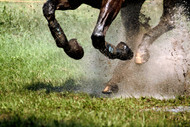Horse First Aid – Bandaging
Posted by Ben Watson on 1st May 2022
Horse First Aid - Everything You Need to Know About Bandaging Your Horse
When it comes to taking care of your horse, it's important to know how to properly apply horse bandages. Incorrectly applied bandages can be dangerous, and in some cases, it's better not to bandage at all. If you're unsure about how to apply bandages correctly
There are many reasons why your horse might need to be bandaged. Common reasons include supporting stiff or sore tendons/ligaments, maintaining warmth, reducing or preventing swelling post-exercise, injury prevention during exercise or traveling, and covering wounds to prevent infection and promote healing.
When bandaging your horse, it's important to use a variety of layers to serve specific functions. The primary layer should be a suitable wound covering, depending on the type of wound. The padding layer should cushion the area and ensure that bandage pressure is distributed evenly across the area. The bandage layer should secure the previous layers and provide compression. Cohesive bandages, such as Easitape or Vetrap, are commonly used, though fleece cotton bandages are also available.
Before applying the bandage, make sure the area is clean and dry. Debris can lead to skin irritation, while moisture can cause fungal infections. It's also essential to ensure correct tension. Too tight and the bandage will impede circulation, and too slack will fail to provide adequate support, slip and bunch, causing pressure points that may impede circulation and damage tendons.
To ensure even distribution of pressure, leg wrapping should be done in a spiral fashion with 50% overlap between layers. For left leg wrap, go anti-clockwise, and for right legs, go clockwise, to apply tension to the front of the leg rather than the tendons at the back. The wrap should start and finish over the bone to prevent loosening due to constant movement on the joint.
If you're applying bandages for travel or exercise, wrap the horse's limbs in pairs. Once applied, check the bandages regularly and reapply as necessary. In any case, bandages should be changed at least every 24 hours.
At Hyperdrug, we offer a wide range of horse bandages perfect for covering wounds, providing compression, keeping tendons and ligaments warm, and cushioning against knocks. We also provide a variety of options for different needs, including vet wrap, cohesive bandages, and gamgee dressings. Visit our website today to shop for high-quality bandages and dressings that will protect and support your horse.
Investing in the right horse bandages is essential for any horse owner. At Hyperdrug, we understand this and offer a wide range of options to choose from. Our bandages are made from high-quality materials that are designed to provide excellent support and protection for your horse's limbs. We also have different types of bandages available, including self-adhesive bandages, non-stick dressings, and fleece bandages. You can find the perfect bandage for your horse by browsing our collection of horse bandages and dressings online.

